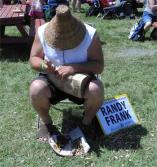I feel like I’m closer to understanding why the cost of food has shot up this year, thanks to the first of a new four part radio series from BBC. Our Food Our Future looks at the reasons behind current price rises and what may lie ahead in the future.
In the program, Tom Heap investigates the truth behind what we’ve been told: that higher costs are due to the rises in costs of raw materials (and yet EU figures say that, for example, raw material costs of bread and cereals were 19% of the supermarket costs, and in 2008 they are 4%); increased consumption of wheat by India (actually 2% per year) and China (static); increased production of biofuels (increased in USA from 43 million tons to 63 million tons in the past year, but has also increased exports); and climate change, in its most popular recent example the Australian drought (but Australia only produces 3% of world wheat: the drought meant loss of 10 million tons out of worldwide production of 600 million tons).
His conclusion was that there is in fact some truth in all these things, but not only that: because the production and consumption figures worldwide are now so close, any small change in any aspect of production or consumption will shake the whole system.
The whole thing began with postwar agricultural subsidies that aimed to boost production at any cost; other factors like political liberalisation of countries such as Russia (with the collapse of farming collectives) and global shifts in production and agricultural land availability have all affected global food production.
When the postwar subsidies were withdrawn in Europe, farmers began finding ways to cut costs rather than boost yields, so yields stabilised, production went into decline (with supermarket pressures for low prices and no government guarantees to shore up farming incomes) and the global food surplus was shrinking.
So we have less surplus right now to pad out shortfalls caused by climactic or economic crises, and any little thing can tip the world into shortages. As well, wealthy western shoppers, instead of adapting to high prices (caused by shortages) by traditional behaviours such as substituting cheaper goods, are pushing prices up still further by simply paying whatever it costs to buy whatever they’re used to having. Because they can.
And finally, food commodity markets are being used by derivatives traders to offset other debts, adding another factor that makes food prices more volatile.
The technology that we depend on now to boost agricultural yields is artificial nitrogen, created through heavy use of oil; an estimated 50% of agricultural costs now are tied to producing fertiliser. The commentator drew one scary comment from an interview subject: since its introduction after WW2 artificial nitrogen has allowed the world’s population to increase unchecked, by boosting yields (with less and less nutritious crops). The global population is such that now we have outstripped the yield that could be generated by natural nitrogen cycles, so we are facing the real possibility of not being able to feed the world even now. Which I guess is why the recent Unesco report on world farming was so firm on the use of organic farming practices, which include natural means of soil enrichment.
Part 2 airs on Monday.









